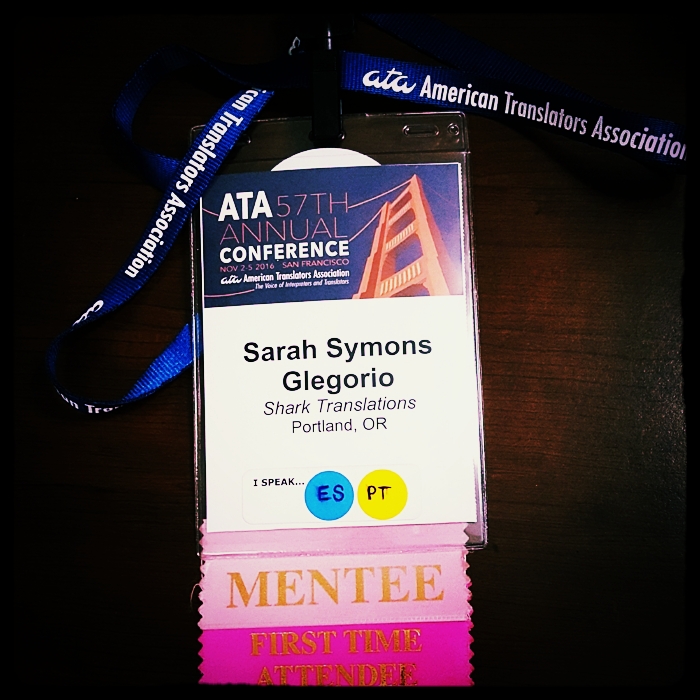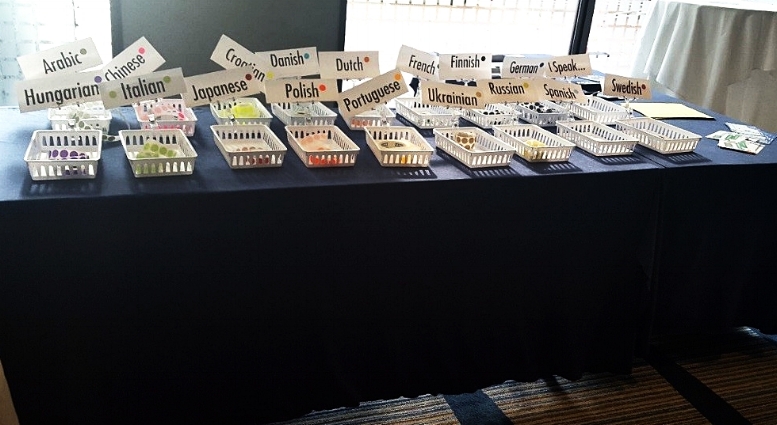What I Learned from the 57th ATA Conference
/It was my first time attending the annual ATA (American Translators Association) conference, which this year was held November 2-6 in San Francisco. I was equally giddy and nervous. Being surrounded by so many worldly multilinguals was awe-inspiring. It felt like I had found my tribe. I saw famous people (famous to me and those in the translation world) on the escalator and they smiled and are real, approachable people!
Smattering of the languages represented
Networking for Introverts
As a first timer and an introvert, I had the best possible introduction to the conference. The first session was “Networking for Introverts” by Anne Goff, which had me chuckling right away with the tip: “Don’t go to networking events!” The idea is that if events are marketed as such i.e., “after-work networking” then they’re usually full of semi-desperate, CV-shoving people who just want to unload their stack of papers rather than develop relationships. However, if an event has an interesting topic and can be a learning opportunity, then go! Another trick to get introverts to network is to RSVP or pay a registration fee. You’ll be more motivated to go if you have someone to meet there or if you’ll lose money by not showing up. Look up current events before going. Network for career advice and come up with questions in advance. At presentations, say hello to the people sitting nearby and ask their opinions. The most important part is to FOLLOW UP afterwards. Text or email the people you’ve met within 24 hours. Follow up again and not just once. Do so a few days, and months afterwards and keep the cycle going to maintain the relationship. Finally, don’t thank people for taking the time to meet with you because then it sounds like you don’t offer anything.
Buddies and Newbies
ATA offers a Buddies and Newbies program where they pair conference veterans with first timers to meet before the conference begins and possibly attend a session together. Since the buddy to newbie ratio was about 5:1, my buddy, Jamie Hartz graciously herded a flock of newbies around and we all had lunch together. It was the perfect way to meet new colleagues and I would highly recommend anyone going to be either a buddy or a newbie.
Areas for Translator Improvement
After reading her column “Fire Ant and Worker Bee” the Translation Journal for years, and reading her book “The Prosperous Translator”, it was an honor to see Chris Durban in person. Her presentation “What About Blind Spots” presented some potentially uncomfortable truths for translators. Some blind spots, or (unknown) areas of improvement for translators, are relatively easy to fix, such as developing business skills. Others that take more time are deepening your knowledge of your source language(s) and specialization(s). The bottom end of the translation market will eventually be taken over by machine translation (artificial intelligence) so it is incredibly important to hone your skills. The hardest truths for translators to both see and fix are work quality and client satisfaction. Improving the quality of your work takes time and practice, even with regular feedback and collaboration with a reviser.
Future of Translation
Honing your skills to keep your job from being taken by machine translation was also underscored in the session about the future of translation “Future Tense” by Jay Marciano. According to Jay, “All MT claims are hyped up.” They act like they’re going to change everything and be revolutionary but they’re not. I take that as meaning machine translation will bring about a lot of change, but we’ll have time to change with it, if we sharpen our skill sets. Translators need to learn to work with the technology rather than trying to race against it. Some of Jay’s recommendations include:
· Become a super native speaker of your target language. That’s not replaceable by machines.
· Take a logics course and get familiar with algorithmic thinking.
· Be comfortable with databases.
Financial Terminology
The “Capital Markets” session by Marian Greenfield was great for succinctly clarifying concepts. She emphasized the importance of finding monolingual glossaries in each language because they are better quality than bilingual glossaries since they go into more depth and are developed by industry professionals. I was happy that she also confirmed a nagging doubt of mine that English doesn’t clearly distinguish between “participation” and “share” as is commonly done in Spanish and other Romance languages (participación vs. acción). It’s stumbled me before how to deal with both versions in a text when you can use “share” for both in English. Another possibility would be to use “unit” in an investment fund. For further reading, she recommended The Intelligent Investor by Ben Graham.
Analyzing Contracts
The session I couldn’t take notes fast enough in was “Contracts: Friends or Foes” by Amanda Williams of Mirror Image Translations. She has some great comebacks for shady clauses in translation agency contracts. Keep in mind though, that we needn’t be combative to get clauses changed. She recommends to say something along the lines of “I read this clause. I’m not 100% on-board because ___. Can we talk about it?” One of the more shocking clauses included forbidding the translator from contacting an agency’s future or potential customers. Does that mean I’m not supposed to look for another customer ever again!? Another one that gave me a chuckle was a clause forbidding translators from discussing compensation with other linguists. According to Amanda, that is a sign they’re not paying enough! In addition to her great comebacks, she also has an excellent “Spec sheet” that she uses to outline details of any project she takes on.
Cost Breakdown
The total cost of attending the conference broke down as follows:
· Food, transportation in San Francisco: $231.86
· Airline tickets: $261.40 (2 round-trip tickets PDX – SFO)
· Hotel: $666.44 (2 nights)
· Conference: $525.00
· Exam: $300.00
· Total: $1984.70
My costs were likely higher than other people’s for a variety of reasons. For one, I took the ATA exam while in San Francisco, which was an additional $300.00 that most people didn’t pay. The opportunity cost in that was having to forgo all of the Saturday conference sessions so I could be 100% focused on the exam. Another cost I paid higher for was the hotel. Being in the 3rd trimester of pregnancy, I needed something close to the conference location, so I found a hotel within 5 blocks; Club Quarters Hotel, which I highly recommend if you need a place to stay in San Francisco’s financial district. The airline tickets were for two people and included a discount for credit card points, although the distance was relatively short. Time will tell if the contacts made and lessons learned will generate or save enough money to cover expenses for the next conference.
Conclusion
All in all, the conference was equally inspiring and overwhelming. It’s absolutely impossible to take it all in so you will inevitably miss out on things. I met some incredible people and got to attend some eye-opening presentations with lessons I’ll be working on implementing. The best advice I could give to my future self and anyone else thinking to attend an ATA conference is to get enough sleep before you go. Have someone to meet up with. Take a water bottle, copious notes, and frequent breaks!
Sources:
1. Anne Goff, “Networking for Introverts” (presentation, American Translators Association 57th Annual Conference, San Francisco, CA, November 3, 2016).
2. Chris Durban, “What About Blind Spots” (presentation, American Translators Association 57th Annual Conference, San Francisco, CA, November 3, 2016).
3. Jay Marciano, “Future Tense – Where will AI & Improving Technologies Take Us in 5 Years?” (presentation, American Translators Association 57th Annual Conference, San Francisco, CA, November 3, 2016).
4. Amanda Williams, “Contracts: Friends or Foes” (presentation, American Translators Association 57th Annual Conference, San Francisco, CA, November 3, 2016).
5. Marian S. Greenfield, CT, “Capital Markets Concepts and Terminology” (presentation, American Translators Association 57th Annual Conference, San Francisco, CA, November 3, 2016).


